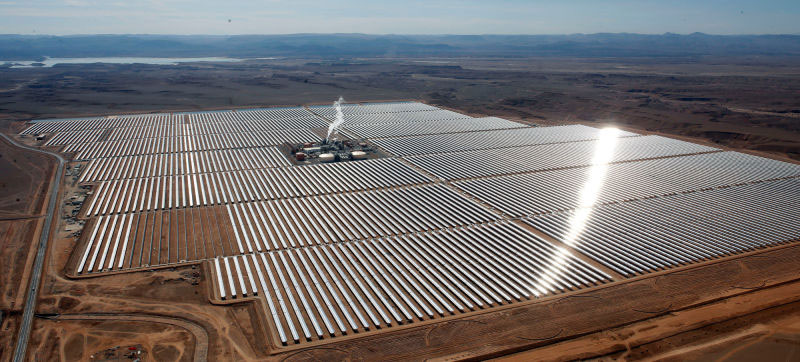Morocco’s King Mohammed VI inaugurated the first phase of what will eventually be the world’s biggest concentrated solar energy plant. The project is intended to slash greenhouse gas emissions. The massive plant is located outside the central city of Ouarzazate, on the edge of the Sahara desert.
[Voice of America/VOA News]
The first wave of power production is known as Noor 1. Its crescent-shaped solar mirrors follow the sun to soak up sunlight all day long. The mirrors, each of which is 40 feet tall, focus light onto a steel pipeline that carries a synthetic thermal oil solution. The oil in those pipes can reach 740℉, and that’s what’s used to create electricity: The heat is used to create steam which drives turbines. The hot oil can be stored to create energy overnight, too.
[Jamie Condliffe/GIZMODO]
The Noor I power plant is capable of generating up to 160 megawatts of power and covers thousands of acres of desert, making the first stage alone one of the world’s biggest solar thermal power plants. When the next two phases, Noor II and Noor III, are finished, the plant will be the single largest solar power production facility in the world, The Guardian says.
Morocco currently relies on imported sources for 97 percent of its energy consumption, according to the World Bank, which helped fund the Noor power plant project. Investing in renewable energy will make Morocco less reliant on those imports as well as reduce the nation’s long-term carbon emissions by millions of tons.
[Camila Domonoske/NPR]
“It is a very, very significant project in Africa,” said Mafalda Duarte, the manager of Climate Investment Funds (CIF), which provided $435m (£300m) of the $9bn project’s funding. “Morocco is showing real leadership and bringing the cost of the technology down in the process.”
“Morocco knew their demand for electricity was growing at 7% a year and that they were dependent on imports for 97% of that energy,” Duarte said. “They had a vision to promote renewables at a time when oil prices were high and they undertook regulatory reforms, put institutions in place, and they have done a great job.”
[Arthur Neslen/THE GUARDIAN]










Comments